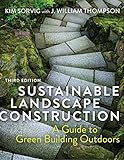Sustainable landscape construction : a guide to green building outdoors / Kim Sorvig with J. William Thompson ; with drawings by Craig D. Farnsworth.
Material type: TextPublication details: Washington, DC : Island Press, [2018]Edition: Third editionDescription: xxx, 471 pages : illustrations ; 29 cmISBN:
TextPublication details: Washington, DC : Island Press, [2018]Edition: Third editionDescription: xxx, 471 pages : illustrations ; 29 cmISBN: - 9781610918091
- 1610918096
- 161091810X (paperback)
- 9781610918107 (paperback)
- TH380 .T46 2018
| Item type | Current library | Call number | Status | Date due | Barcode | Item holds | |
|---|---|---|---|---|---|---|---|
| Non-lending Books | Elisabeth C. Miller Library Tall Shelves | QH541.5.C6 S67 2018 (Browse shelf(Opens below)) | Not for loan | 39352800179012 |
Order of author names reversed in previous edition.
Includes bibliographical references and index.
Basic principles : "Sustainability" in context -- Principle 1 : Keep healthy sites healthy -- Principle 2 : Heal injured soils and sites -- Principle 3 : Favor living, flexible materials -- Principle 4 : Respect the waters of life -- Principle 5 : Pave less -- Principle 6 : Consider origin and fate of materials -- Principle 7 : Know the costs of energy over time -- Principle 8 : Celebrate light, respect darkness -- Principle 9 : Quietly defend silence -- Principle 10 : Maintain to sustain -- Principle 11 : Demonstrate performance, learn from failure -- Sustaining principles, evolving efforts.
Since the publication of the first edition in 2000, Sustainable Landscape Construction has helped to spur a movement towards resilient outdoor environments, in the U.S. and throughout the world. The third edition has been updated to include important recent developments in this landscape revolution. It remains essential reading for everyone with an interest in "green" design of outdoor spaces and infrastructures.Like its predecessors, the new edition of Sustainable Landscape Construction is organized around principles, recognizing that built environments, and our work in them, pose both pragmatic and ethical challenges. Each chapter focuses on one overarching site goal, such as "Pave Less," "Heal Injured Sites," and "Consider Origin and Fate of Materials." These principles of land sustainability are clearly articulated and developed through specific examples of more than 100 projects from around the world, reflecting both traditions and recent innovations. Expanded coverage of industry trends toward performance monitoring, and of lessons from project failures, form an important enhancement in this edition. New content also details the necessity to plan adaptively, not just preventively, for the realities of changing climate and intensifying weather. Some of the trends covered will shift how landscape architects and contractors will do business in challenging years ahead: to survive, many professionals and clients will focus on restoration projects, motivated by ecosystem services and social justice, and funded by innovative methods.Sustainable Landscape Construction is part of the canon of landscape construction texts, and with this update, remains a visionary, one of a kind reference for professionals and students.
